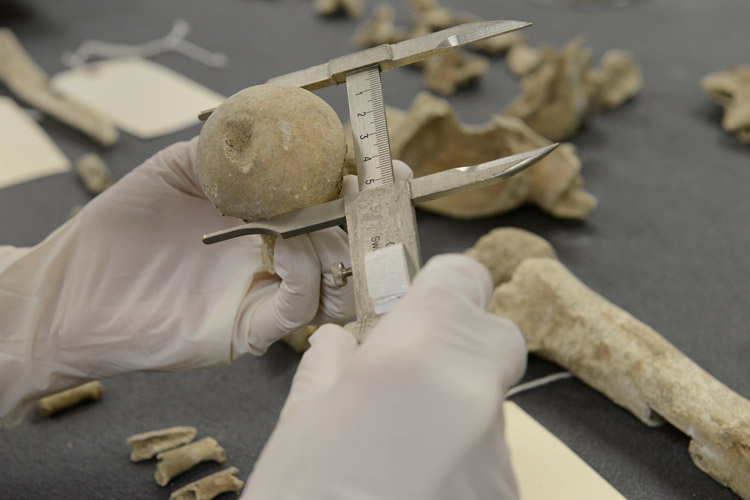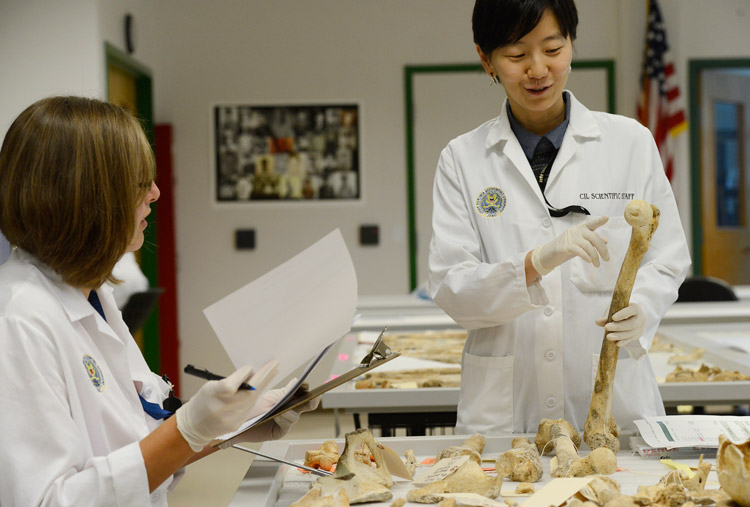HONOLULU — Twenty-two teeth, a fragment of a denture, a clavicle, a radius, a fibula and small fragments of a femur.
That was all that remained of one of the crew members of a bomber was shot down over New Guinea in 1944. Investigators would eventually determine the teeth and bones belonged to Tech. Sgt. Charles L. Johnston of Pittsburgh.
Two decades ago those remains wouldn’t have been enough for identification.
Now, useful DNA can be extracted from small bone fragments, even ones like these that had been eroding in sticky jungle clay for 65 years.
This is how government scientists identified Sgt. Johnston’s remains:
Anthropologists at the Defense POW/MIA Accounting Agency in Honolulu cut samples from six bones and sent them to the Armed Forces Medical Examiner System at Dover Air Force Base in Dover, Del.
Told only that the remains were from the World War II era, DNA analyst Michelle Ackermann was assigned to the case. Analysts are purposely kept in the dark about the cases they’re working on to protect the integrity of the case from bias that can occur when a scientist expects a certain result.


Wearing goggles, gloves and a lab coat to protect against cross-contamination, Ms. Ackermann first sanded each bone fragment with a rotary grinding tool to remove debris. Then she rinsed the fragments in distilled water, washed them in ethanol and pulverized them in a blender to make a fine powder. Next she added a chemical detergent buffer that causes bone to release DNA.
Mitochondrial DNA, which is passed through maternal lines, is durable and plentiful. There are hundreds — sometimes thousands — of copies in each cell. That’s one reason government scientists prefer to analyze it before looking at nuclear DNA, which passes through both sides of a family but is rarer, with only a single copy per cell.
Still, mitochondrial DNA isn’t the unique identifier most people think it is.
There is a 7 percent chance that any random pairing of Caucasians will share the same mitochondrial DNA.
“Like last names, a lot of different people could actually have the same mitochondrial DNA, so we can’t solely rely on mitochondrial DNA to make and identification,” said Jennie Jin, a DPAA scientist in Hawaii who works primarily on identifying remains from the Korean War.
There are 7,852 MIAs from the Korean War, and the Armed Forces DNA Identification Laboratory has family reference samples for 90 percent of them. The trouble is that about 900 of them share the same mitochondrial DNA, Dr. Jin said.
In the case that was assigned to Ms. Ackermann, she was able to extract good DNA and run it through a thermal cycler, which “amplifies” — that is, copies — it. Each cycle doubles the amount of DNA.
Ms. Ackermann repeated the process dozens of times, conducting multiple tests on each tooth and bone fragment in this set of remains.
“We’re looking for overlapping data to see if what we’re getting is authentic and reproducible. If it isn’t then we have to start over,” she said.
Next she ran the results of her analysis through the DNA reference samples collected from relatives of missing service members. A grandmother would have the same mitochondrial DNA as her daughters, children of her daughters and children of her granddaughters.
Sgt. Johnston’s DNA turned out to be rare. There wasn’t a single match in DNA Identification Lab’s database of 24,020 samples.
Back in Hawaii, anthropologists with fuller information about the case had a better idea of whose remains these were.
“Because of the historical records and the material evidence we know what individuals were on that aircraft … so that really narrows it down,” said Audrey L. Meehan, a DNA sampling specialist at the Honolulu lab.
That meant that researchers could concentrate on obtaining DNA samples from the families of the crew members aboard the downed B-24, including relatives of Sg. Johnston.
Geneaological searches
But first, they had to find them. It would be up to Therese Fisher to search for Sgt. Johnston’s family. The Mississippi-based genealogist had already helped find hundreds of relatives of missing service members. The Army hired her to help it track down Sgt. Johnston’s family.
This time, her search brought her to the City-County Building in Pittsburgh. Combing through public records, she uncovered a probate filing that bore the same address that had been on Sgt. Johnston’s enlistment records.
“Once I read that line it was exhilarating. I was on the right track,” she said. “It was also discouraging because I knew then and there that there was only one other sibling and no sisters” who would have carried the mitochondrial DNA line forward to her own children. “I said now I’ve got to find the mom’s line.”
Her hunt for relatives of the sergeant’s mother turned up posts in an online forum by a Carol Schake of South Carolina, who had also been seeking information on the McGann family. Mrs. Fisher sent an email message.


“She wanted to know ‘How are you related to Mildred McGann Johnston?’ ” Mrs. Schake remembered. “I said, ‘She’s my aunt.’ ”
Later that day Mrs. Schake got a call from a military casualty officer.
“She said they think they found Chuck, and I about dropped the phone,” she said. “I had no idea anybody was still looking for him.”
Now the military was looking for someone else, too: the sergeant’s brother, Robert Johnston. As a sibling he would share the same mitochondrial DNA and probably about half of the same nuclear DNA. A match would confirm that the remains were his brother’s.
Mrs. Schake had been looking for him, too. The family had grown apart and she never knew what had become of the boy they’d called Bobby. Her own research as an amateur genealogist had turned up innumerable Robert Johnstons but none of them turned out to be her cousin.
She gave up and so did Ms. Fisher, who was nearing the $2,500 limit the Army authorized for her work on the case. It was August 2011.
Meanwhile, Mrs. Schake had submitted a sample of her own DNA, as did her brother Bill Mall.
Both were matches to the remains recovered in New Guinea.
That gave scientists confidence these were Sgt. Johnston’s remains, but they still had more work to do back in the lab in Honolulu.
A positive identification requires excluding all other unknowns who might have been killed in the same area, Dr. Jin said.
A misidentification could be disastrous for DPAA, which has faced its share of criticism from members of Congress, former agency scientists, the Government Accountability Office and would-be contractors who say they could do a better job.
The Honolulu lab




In Honolulu, anthropologists in white coats and latex gloves turn bones over and over in their hands, running their fingers over grooves, studying muscle attachment points for symmetry and looking for perfect articulation with other bones.
Around them, other remains, some of which are complete skeletons, are laid out on 17 sterile tables. Every skull faces the American flag outside the glass-enclosed laboratory on Joint Base Pearl Harbor-Hickam.
Across the lab, odontologist Calvin Y. Shiroma analyzed the fragmented and poorly preserved teeth. He reconstructed some of the fragments using wax.
A lone dental record from October 1943 was available in Sgt. Johnston’s military records. It confirmed he’d had a denture like the one found among the remains, but it raised other questions.
First, five of the recovered teeth had fillings, but dental records didn’t show evidence of that work. Sgt. Johnston could have had the fillings done outside the military in the six months between that dental exam and his death, but Dr. Shiroma couldn’t be sure.
Second, the dental chart indicated missing wisdom teeth, yet those teeth were found among the remains. Without dental X-rays, the dentist who examined him in 1943 might not have realized the teeth hadn’t yet poked through the 19-year-old’s gums, Dr. Shiroma said in his report.
Comparisons with records of the plane’s other crew members boosted Dr. Shiroma’s confidence that this could be a match to Sgt. Johnston. This set of teeth couldn’t belong to any of the others.
Finally, on June 25, 2014, the lab determined that the “analysis and the totality of the circumstantial evidence” was enough to establish that the remains belonged to Sgt. Johnston. In the same report the lab confirmed the identities of the seven crew members who died with him and were identified using similar methods.
A personal stake
The scientists involved in the tedious identification process get attached to their cases. The men in pictures on the desks of anthropologists like Carrie LeGarde aren’t husbands or boyfriends but soldiers they helped identify.
“We end up being very invested in their cases. We spend a lot of time with them,” said Ms. LeGarde, who is starting a doctoral program in the fall at the University of South Florida.
“I’m excited about grad school but I don’t want to leave my guys,” she said. “I want to identify them.”
The efforts amazed Sgt. Johnston’s niece Terri Gelbart, a DNA expert and medical researcher in San Diego.
“You can now get these old dried-up bones and extract DNA from them. The capacity for sequencing is amazing. It’s very complex. A lot of DNA analysis goes into it,” said Mrs. Gelbart, who was born long after her uncle died.
She was thankful to have her uncle identified and buried with military honors, but some part of her wonders if the effort is too much.
“Although I think it’s a great thing for the families that are affected and its great for [troops serving now] to know the extent the military will go to for them, it takes a lot of money and manpower. You do wonder if it’s all worth it,” Mrs. Gelbart said.
Previous Chapter Next Chapter